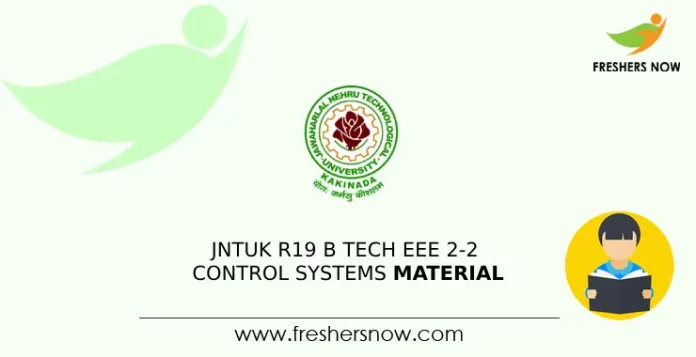
JNTUK R19 B.Tech 2-2 Control Systems Material/ Notes PDF Download: This course provides an overview of linear control systems and their analysis. JNTUK R19 B.Tech Control Systems Notes covers classical design methods using frequency response techniques. Additionally, it introduces the state space approach for modeling and designing control systems, emphasizing the application of simple PD and PID controllers. Students will gain practical insights into the modeling and analysis of these controllers, which are crucial components in control engineering.
JNTUK R19 B.Tech 2-2 Control Systems Material – Chapters
| No. Of Units | Name of the Unit |
| Unit – 1 | Mathematical Modeling of Control Systems |
| Unit – 2 | Time Response Analysis, Stability, and Root Locus Technique |
| Unit – 3 | Frequency Response Analysis |
| Unit – 4 | Classical Control Design Techniques |
| Unit – 5 | State Space Analysis of LTI Systems |
Unit 1 Syllabus PDF Download | JNTUK R19 B.Tech Control Systems Material
Mathematical Modeling of Control Systems: Classification of control systems, open loop and closed loop control systems and their differences, Feedback characteristics, the transfer function of a linear system, differential equations of electrical networks, translational and rotational mechanical systems, the transfer function of DC servo motor – AC servo motor – synchro, transmitter, and receiver – block diagram algebra – representation by signal flow graph – reduction using Mason’s gain formula.
| JNTUK R19 B.Tech 2-2 Control Systems Material – PDF Download | |
| To Download JNTUK R19 B.Tech EEE CS Unit – 1 Notes PDF | Download PDF |
Unit 2 Syllabus PDF Download | JNTUK R19 B.Tech Control Systems Notes
Time Response Analysis: Standard test signals – time response of first and second order systems – time domain specifications, steady state errors and error constants, P, PI,
Stability and Root Locus Technique: The concept of stability – Routh’s stability criterion –limitations of Routh’s stability, Root locus concept – construction of root loci (simple problems).Effect of addition of poles and zeros root locus
| JNTUK R19 B.Tech 2-2 Control Systems Material – PDF Download | |
| To Download JNTUK R19 B.Tech EEE CS Unit – 2 Notes PDF | Download PDF |
Unit 3 Syllabus PDF Download | JNTUK R19 B.Tech Control Systems Material
Frequency Response Analysis: Introduction to frequency domain specifications – Bode diagrams – transfer function from the Bode diagram – phase margin and gain margin – stability analysis from Bode plots. Polar plots, Nyquist stability criterion.
| JNTUK R19 B.Tech 2-2 Control Systems Material – PDF Download | |
| To Download JNTUK R19 B.Tech EEE CS Unit – 3 Notes PDF | Download PDF |
Unit 4 Syllabus PDF Download | JNTUK R19 B.Tech Control Systems Material
Classical Control Design Techniques: Lag, lead, lag-lead compensators, design of compensators using Bode plots.
| JNTUK R19 B.Tech 2-2 Control Systems Material – PDF Download | |
| To Download JNTUK R19 B.Tech EEE CS Unit – 4 Notes PDF | Download PDF |
Unit 5 Syllabus PDF Download | JNTUK R19 B.Tech Control Systems Material
State Space Analysis of LTI Systems: Concepts of state, state variables and state model, state space representation of transfer function, diagonalization, solving the time-invariant state equations, State Transition Matrix and its Properties, concepts of controllability and observability.
| JNTUK R19 B.Tech 2-2 Control Systems Material – PDF Download | |
| To Download JNTUK R19 B.Tech EEE CS Unit – 5 Notes PDF | Download PDF |
For more details about JNTUK R19 B.Tech 2-2 Control Systems Material and other materials follow our official website Freshersnow.com.
JNTUK R19 B.Tech 2-2 Control Systems – Outcomes
- Derive transfer functions using Laplace transforms and determine overall transfer functions through block diagram algebra and signal flow graphs.
- Analyze second-order systems to determine time response specifications and calculate error constants.
- Use Routh’s stability criterion and the root locus method for absolute and relative stability analysis of LTI systems.
- Apply frequency response methods to analyze stability in LTI systems through Bode diagrams.
- Design Lag, Lead, and Lag-Lead compensators based on Bode diagrams for improved system performance.
- Represent physical systems as state models and analyze system response considering controllability and observability concepts.



